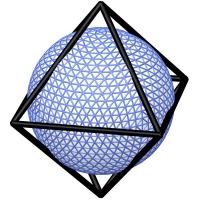What is the octahedral grid ?The octahedral grid has been inspired by the Collignon Projection of the sphere onto an octahedron.  It is a form of reduced Gaussian grid with the same number of latitude lines located at the same latitude values as those of a original Gaussian grid but with the number of longitude points at each latitude circle computed according to the formula: | Mathdisplay |
|---|
\begin{eqnarray*}
\mbox{N}_{lat}(lat_N) & = & 20 \\
\mbox{N}_{lat}(lat_i) & = & \mbox{N}_{lat}(lat_{i+1}) + 4, \mbox{ for } i=\mbox{N} - 1,\ldots,1
\end{eqnarray*} |
In other words, there are 20 longitude points at the latitude circle closest to the poles with the number of points increasing continuously by 4 at each latitude towards the equator. This is in contrast to the original reduced Gaussian grid where there are 'jumps' between blocks of latitudes with a constant number of longitude points (a restriction imposed by the Fast Fourier Transform routines being used up to IFS cycle 41r1). As a consequence, the zonal resolution of the octahedral grid varies more with latitude than for the original reduced Gaussian grid. This can be seen in the figures to the right. Note in particular that the octahedral grid has 4N + 16 longitude points at the latitude circle closest to the equator whereas the original reduced Gaussian grid has 4N longitude points at the latitude circle closest to the equator. There are also fewer total grid points in the octahedral grid compared to the original reduced Gaussian grid.For example, the N1280 O1280 octahedral grid has about 20% fewer grid points than the equivalent N1280 linear original reduced grid. Generally, an octahedral grid of resolution N has 4xNx(N+8) grid points. The octahedral grid has been shown to improve the calculation of local derivatives in grid point space. |